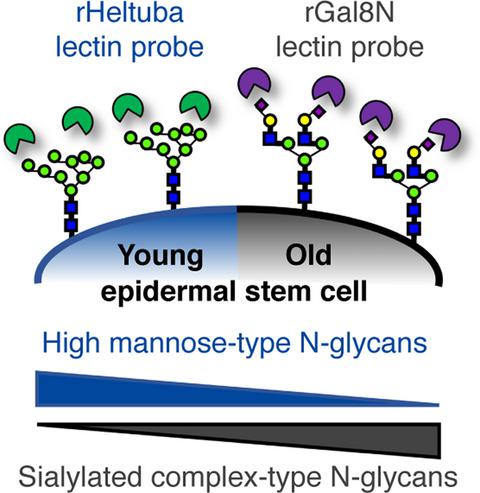当前位置:
X-MOL 学术
›
Aging Cell
›
论文详情
Our official English website, www.x-mol.net, welcomes your
feedback! (Note: you will need to create a separate account there.)
Glycome profiling by lectin microarray reveals dynamic glycan alterations during epidermal stem cell aging.
Aging Cell ( IF 8.0 ) Pub Date : 2020-07-18 , DOI: 10.1111/acel.13190 Lalhaba Oinam 1, 2 , Gopakumar Changarathil 1, 3 , Erna Raja 1, 4 , Yen Xuan Ngo 1, 2 , Hiroaki Tateno 1, 5 , Aiko Sada 1, 4 , Hiromi Yanagisawa 1, 6
Aging Cell ( IF 8.0 ) Pub Date : 2020-07-18 , DOI: 10.1111/acel.13190 Lalhaba Oinam 1, 2 , Gopakumar Changarathil 1, 3 , Erna Raja 1, 4 , Yen Xuan Ngo 1, 2 , Hiroaki Tateno 1, 5 , Aiko Sada 1, 4 , Hiromi Yanagisawa 1, 6
Affiliation

|
Aging in the epidermis is marked by a gradual decline in barrier function, impaired wound healing, hair loss, and an increased risk of cancer. This could be due to age‐related changes in the properties of epidermal stem cells and defective interactions with their microenvironment. Currently, no biochemical tools are available to detect and evaluate the aging of epidermal stem cells. The cellular glycosylation is involved in cell–cell communications and cell–matrix adhesions in various physiological and pathological conditions. Here, we explored the changes of glycans in epidermal stem cells as a potential biomarker of aging. Using lectin microarray, we performed a comprehensive glycan profiling of freshly isolated epidermal stem cells from young and old mouse skin. Epidermal stem cells exhibited a significant difference in glycan profiles between young and old mice. In particular, the binding of a mannose‐binder rHeltuba was decreased in old epidermal stem cells, whereas that of an α2‐3Sia‐binder rGal8N increased. These glycan changes were accompanied by upregulation of sialyltransferase, St3gal2 and St6gal1 and mannosidase Man1a genes in old epidermal stem cells. The modification of cell surface glycans by overexpressing these glycogenes leads to a defect in the regenerative ability of epidermal stem cells in culture. Hence, our study suggests the age‐related global alterations in cellular glycosylation patterns and its potential contribution to the stem cell function. These glycan modifications detected by lectins may serve as molecular markers for aging, and further functional studies will lead us to a better understanding of the process of skin aging.
中文翻译:

通过凝集素微阵列进行的糖组分析揭示了表皮干细胞老化过程中的动态聚糖变化。
表皮老化的标志是屏障功能逐渐下降、伤口愈合受损、脱发和癌症风险增加。这可能是由于表皮干细胞特性的年龄相关变化以及与其微环境的相互作用有缺陷。目前,还没有可用于检测和评估表皮干细胞老化的生化工具。细胞糖基化参与各种生理和病理条件下的细胞-细胞通讯和细胞-基质粘附。在这里,我们探索了表皮干细胞中聚糖的变化作为衰老的潜在生物标志物。使用凝集素微阵列,我们对来自年轻和年老小鼠皮肤的新鲜分离的表皮干细胞进行了全面的聚糖分析。表皮干细胞在年轻和年老小鼠之间的聚糖谱中表现出显着差异。特别是,甘露糖结合剂 rHeltuba 在旧表皮干细胞中的结合减少,而 α2-3Sia 结合剂 rGal8N 的结合增加。这些聚糖的变化伴随着唾液酸转移酶的上调,旧表皮干细胞中的St3gal2和St6gal1以及甘露糖苷酶Man1a基因。通过过度表达这些糖原对细胞表面聚糖进行修饰会导致培养中表皮干细胞的再生能力出现缺陷。因此,我们的研究表明细胞糖基化模式中与年龄相关的整体改变及其对干细胞功能的潜在贡献。凝集素检测到的这些聚糖修饰可以作为衰老的分子标志物,进一步的功能研究将使我们更好地了解皮肤衰老的过程。
更新日期:2020-07-18
中文翻译:

通过凝集素微阵列进行的糖组分析揭示了表皮干细胞老化过程中的动态聚糖变化。
表皮老化的标志是屏障功能逐渐下降、伤口愈合受损、脱发和癌症风险增加。这可能是由于表皮干细胞特性的年龄相关变化以及与其微环境的相互作用有缺陷。目前,还没有可用于检测和评估表皮干细胞老化的生化工具。细胞糖基化参与各种生理和病理条件下的细胞-细胞通讯和细胞-基质粘附。在这里,我们探索了表皮干细胞中聚糖的变化作为衰老的潜在生物标志物。使用凝集素微阵列,我们对来自年轻和年老小鼠皮肤的新鲜分离的表皮干细胞进行了全面的聚糖分析。表皮干细胞在年轻和年老小鼠之间的聚糖谱中表现出显着差异。特别是,甘露糖结合剂 rHeltuba 在旧表皮干细胞中的结合减少,而 α2-3Sia 结合剂 rGal8N 的结合增加。这些聚糖的变化伴随着唾液酸转移酶的上调,旧表皮干细胞中的St3gal2和St6gal1以及甘露糖苷酶Man1a基因。通过过度表达这些糖原对细胞表面聚糖进行修饰会导致培养中表皮干细胞的再生能力出现缺陷。因此,我们的研究表明细胞糖基化模式中与年龄相关的整体改变及其对干细胞功能的潜在贡献。凝集素检测到的这些聚糖修饰可以作为衰老的分子标志物,进一步的功能研究将使我们更好地了解皮肤衰老的过程。











































 京公网安备 11010802027423号
京公网安备 11010802027423号